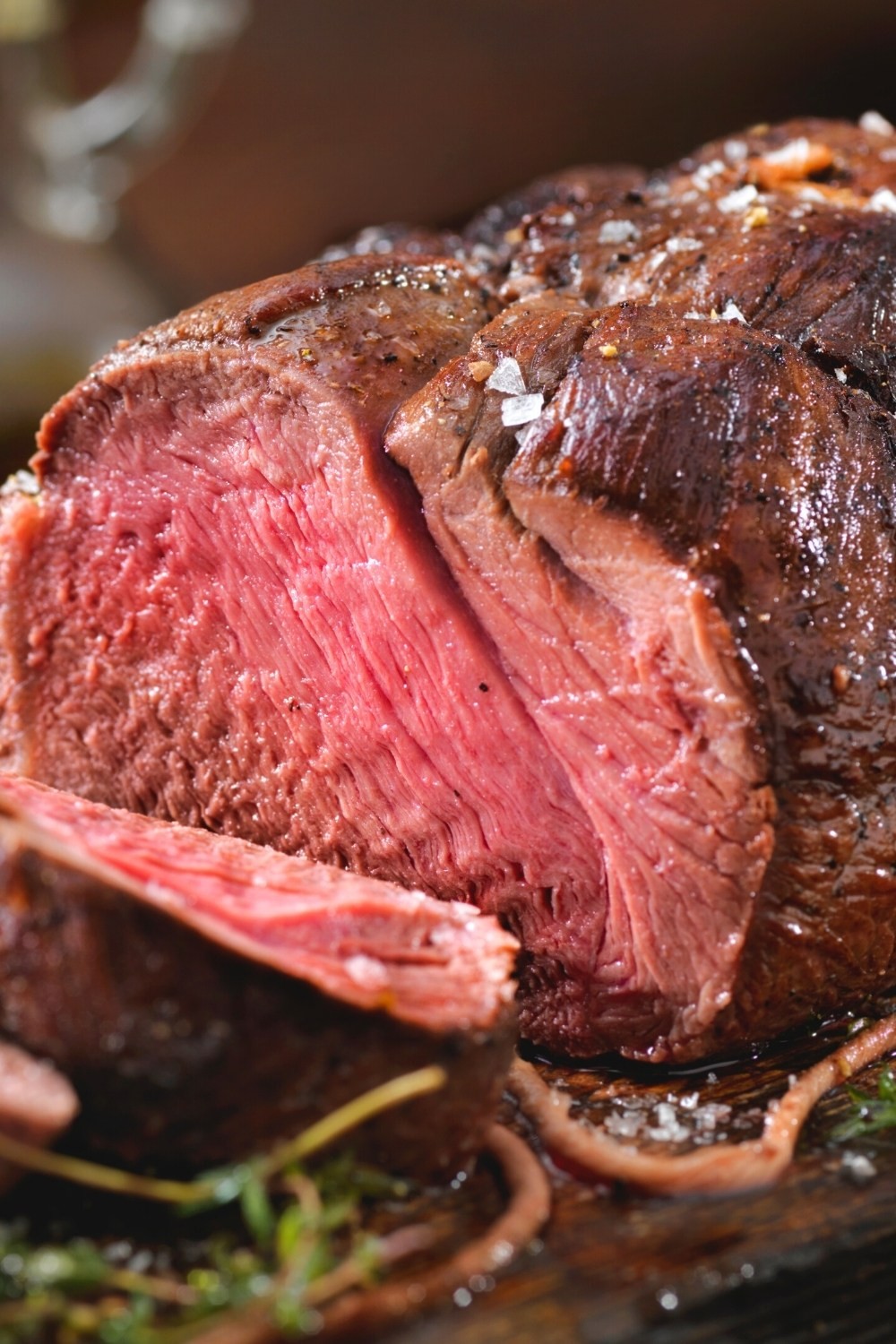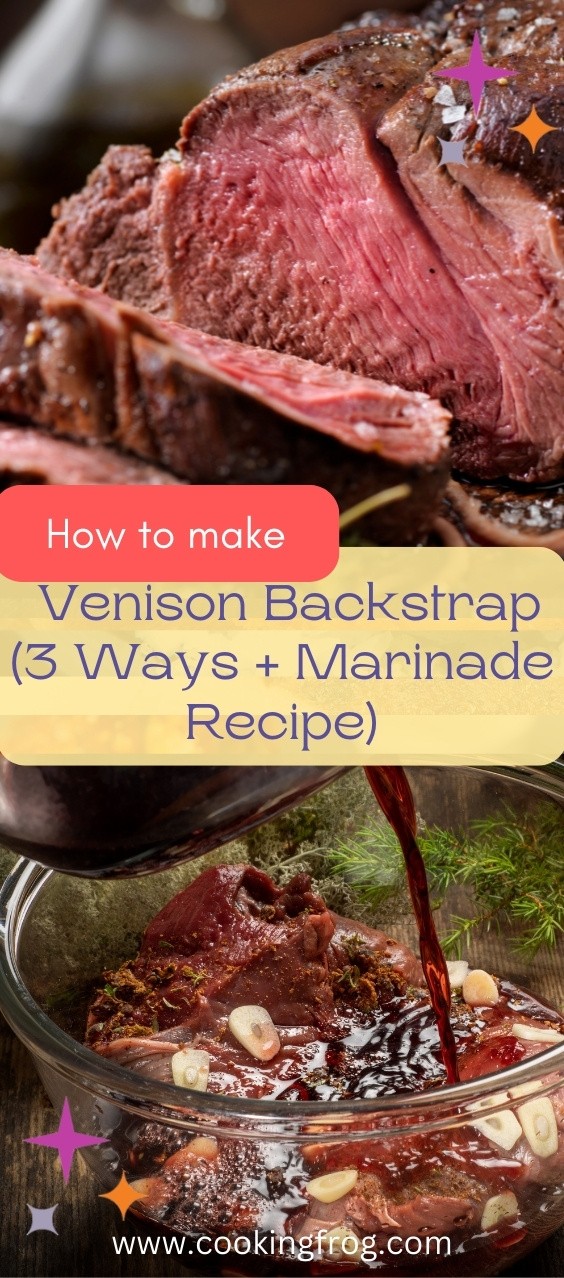Without a doubt, the finest deer cut is the backstrap. It is a no-brainer why this is one of the best wild game cuts since it is simple to prepare and melts in your mouth—a must-have for any cuisine from a rural farmhouse or romantic supper.
If you’re a fan of game meat, be sure to check my Venison Burger and Elk Burger recipe, this Elk burger is one of the most popular recipes on this website.
Fun Fact: Arby’s is paving the way for the mainstream consumption of game meats. In 2016, Arby’s debuted a venison sandwich, which was a limited-time offering that could only be purchased at a select number of locations. People began lining up hours in advance in 2020 when Arby’s brought it back and sold it across the country for only one day; they were eager to get their hands on one.
However, if you want to make Arby’s venison sandwich, you can. Just substitute venison for beef in this Arby’s beef and cheddar sandwich!
What is a Venison Backstrap?
Deer backstrap is exactly what it sounds like. The portion of a deer’s flesh runs down the spine. When it comes to a recipe, it’s best to make it count since you only get two per deer. The spine spans the whole length of the deer’s back and is known as the venison backstrap or venison loin.
But venison tenderloin and backstrap are not the same types of meat. The term “venison tenderloin” refers to the cut of meat located below the backstrap and between the ribs and the rump.
Why is this Venison Backstrap Recipe So Good?
A marinated venison backstrap that is juicy, delicious, and tender is then pan-seared, grilled, or air-fried until it is well browned on the outside and slightly pink within. Creating a recipe for out-of-this-world venison that doesn’t taste gamey is straightforward.
The flavor of venison need not be gamey. This venison backstrap dish is one of my favorites since the marinade enhances the flavor and helps to mask the gamey taste.
Backstrap may be prepared in 3 ways after marinating: pan-seared and finished in the oven, grilled or using an air-fryer. The backstrap of deer is incredibly delicate and juicy when cooked correctly to the optimal internal temperature. You’ll adore it, I can tell!

How to make Venison Backstrap Tender?
If not overdone, venison backstrap is a highly tender piece of meat. Venison backstrap is soft, juicy, and tasty when cooked correctly to medium-rare to medium. In fact, venison will still be delicate and juicy even if you cook it to medium well.
The venison backstrap is marinated in this recipe, which adds a ton of flavor and helps to tenderize the meat further.
How to eliminate the game flavor from venison?
If the venison is recently taken, you may help eliminate the gamey flavor and draw out the blood by soaking the backstrap in buttermilk for a few hours or overnight. Give it a rinse after removing it from the buttermilk.
There is no need to soak the venison in buttermilk if it hasn’t just been harvested. Mix the defrosted venison with the marinade, cover, and refrigerate for up to 24 hours. Venison may be marinated to provide tons of fantastic flavor while also assisting in eliminating any gamey flavor.

Ingredients you’ll need for this recipe.
Olive oil
Soy sauce
Lemon juice
Italian seasoning
Apple Cider vinegar or Balsamic vinegar
Worcestershire
Red Wine
Garlic
Pepper
Allow the backstrap to marinade for a minimum of four hours and ideally up to twenty-four hours, turning it over halfway through to ensure that both sides are covered.
Similar to this steak marinade, which uses the same ingredients, this marinade for wild game is also fantastic for beef.
How to cook Venison Backstrap
Deer backstrap, also known as venison backstrap, is typically prepared in the pan or on the grill; however, air-fryer venison is rising in popularity due to its efficacy.
- Pan-fried venison backstrap with an oven finish
- Grilled venison backstrap
- Air-fryer venison backstrap
Although I like all approaches, I choose to pan-sear and oven-finish my venison backstrap. This seals in all the fluids and gives you a pretty lovely sear.
Use a meat thermometer while cooking venison, as you should with most meat, to prevent overcooking, which makes the flesh tough and dry.
Pan-Fried Venison Backstrap
Step 1: Butter or olive oil should be added to a cast iron or stainless steel pan that may be used in the oven.
Step 2: The venison should be well-browned and caramelized on the outside after being seared in the hot pan on both sides. Heat the oven to 375 degrees Fahrenheit while you are searing the venison.
Step 3: Place the venison backstrap-containing oven-safe pan in the preheated oven. For medium-rare to medium, bake for 12 to 15 minutes or until a meat thermometer registers 130 to 135 degrees Fahrenheit. Before slicing, allow it to rest for at least 5 minutes.
Grilled Venison Backstrap
Step 1: Turn the grill’s heat up to medium-high.
Step 2: For medium-rare to medium, grill the backstrap on each side for 6 to 8 minutes or until a meat thermometer registers 130 to 135 degrees Fahrenheit. Before slicing, allow it to rest for 5 to 10 minutes.
Air-Fryer Venison Backstrap
For the air fryer version of the venison backstrap, you want to cut your backstrap into steak bites before frying.
Step 1: Pre-heat your air fryer to 400 degrees Fahrenheit for 5 minutes
Step 2: Cut your venison into bite-size pieces, and don’t overcrowd your air-fryer. If needed, cook in batches.
Step 2: Cook for 6-7 minutes. The internal temperature should be 130-135 degrees Fahrenheit. Enjoy!
Extra Tips
Remember that it will keep cooking after the meat is removed from the heat source. The temperature will continue to climb 5 to 10 degrees as the remaining heat in the meat continues to cook the meat.
The venison backstrap, for instance, should be removed from the heat source at 130 degrees Fahrenheit and allowed to rest for 5 to 10 minutes until it reaches 135 degrees Fahrenheit if you want it to be cooked to medium (135.5 degrees F).
Venison Internal Temperature Chart
To avoid overcooking the meat and producing dry, tough meat, I highly advise using a meat thermometer while cooking meat. Here are the temperatures for determining the degree of doneness for the venison backstrap:
- Rare: 125 Fahrenheit. (52 Celsius)
- Medium-rare: 130-135 Fahrenheit. (57 Celsius)
- Medium: 135-140 Fahrenheit. (60 Celsius)
- Medium-well: 140-145 Fahrenheit. (62 Celsius)
- Well: 145-150 Fahrenheit. (65 Celsius)
I prefer to cook venison backstrap to a temperature of about 135 F. Although not raw, it is still pink and juicy in the middle, and the edges are caramelized.
Why you should let your Venison rest after cooking
When you cut into cooked meat without letting it rest, all of the fluids will flow out, leaving you with drier meat. This is because cooking attracts all of the liquids to the surface of the flesh.
Therefore, after removing the cooked venison from the heat source, allow it to rest for at least minutes. This makes for soft, juicy slices by redistributing the liquids throughout the meat.
Share the image below to your Pinterest board if you like this venison backstrap recipe!

Venison Backstrap Recipe
Venison Backstrap that has been marinated, then pan-seared, grilled or air-fried until the exterior is well-browned and the interior is just barely pink. Tender, juicy, and full of flavor. Deer meat is straightforward to prepare and melts in your tongue without having a gamey flavor.
Ingredients
For the Venison
- 1 lb. of venison backstrap
- 1 Tbsp of olive oil
For the Marinade
- 4 Tbsp of olive oil
- 4 Tbsp of soy sauce
- 2 Tbsp of lemon juice
- 2 Tbsp of balsamic vinegar (or apple cider vinegar)
- 1 Tbsp of Worcestershire
- 2 Tbsp of Italian Seasoning
- 2 minces garlic cloves
- 1 tsp of black pepper
- 2 Tbsp of Red Wine
Instructions
For the Marinade
- Combine the marinade ingredients in a zip-top bag or small dish. Place in the refrigerator after adding the backstrap. Turning halfway through, marinate for a minimum of 4 hours and a maximum of 24 hours.
- Take the venison out of the marinade, give it a good rinse, and pat it dry for 30 minutes before you’re ready to cook. Place it on a clean platter and give it time to warm up.
Pan-Seared Method
- Set the oven to 375 degrees Fahrenheit.
- Heat olive oil in an oven-safe cast iron or stainless steel pan over medium-high heat. When the pan is heated, add the backstrap and sear on all sides, including the ends, until a lovely brown crust forms. To do this, hold the backstrap in the pan with tongs.
- Move the pan containing the backstrap into the preheated oven if it is an oven-safe skillet. Transfer the backstrap to an oven-safe dish with some olive oil if your skillet doesn’t support the oven’s heat.
For Grilling Method
- Turn on the grill to a medium-high setting.
- Put the venison backstrap on the hot grill and cook it for 6–8 minutes before flipping it over and cooking it for a further 6–8 minutes.
- The backstrap should register between 130 and 135 degrees Fahrenheit on a meat thermometer for medium-rare. Remember that if the heat source is turned off, the body’s temperature will continue to rise. Slice the backstrap after transferring it to a platter and lightly covering it with tinfoil for 5 to 10 minutes. The temperature will increase by another 5 to 10 degrees while the food is resting, getting it even closer to medium doneness.
Air-Frying Method
- Heat your air fryer for five minutes at 400 degrees Fahrenheit.
- Avoid packing your air fryer too tightly, and cut your venison into bite-sized pieces—Cook in batches as necessary.
- Cook for 6-7 minutes. The temperature on the inside should be between 130 and 135 degrees Fahrenheit. Enjoy!


